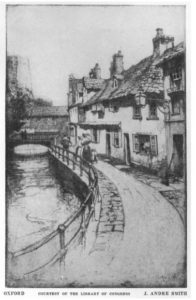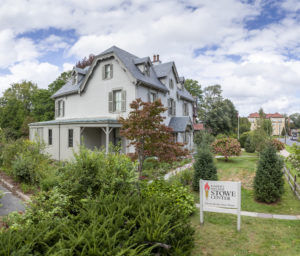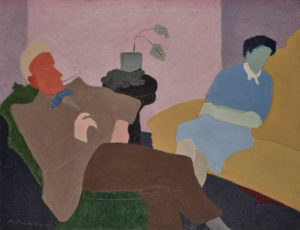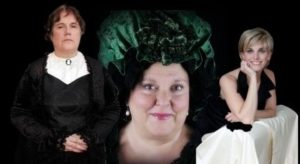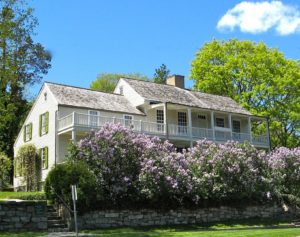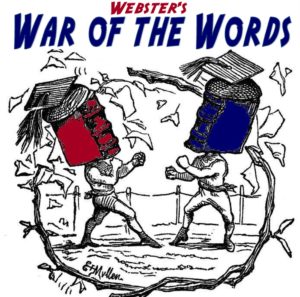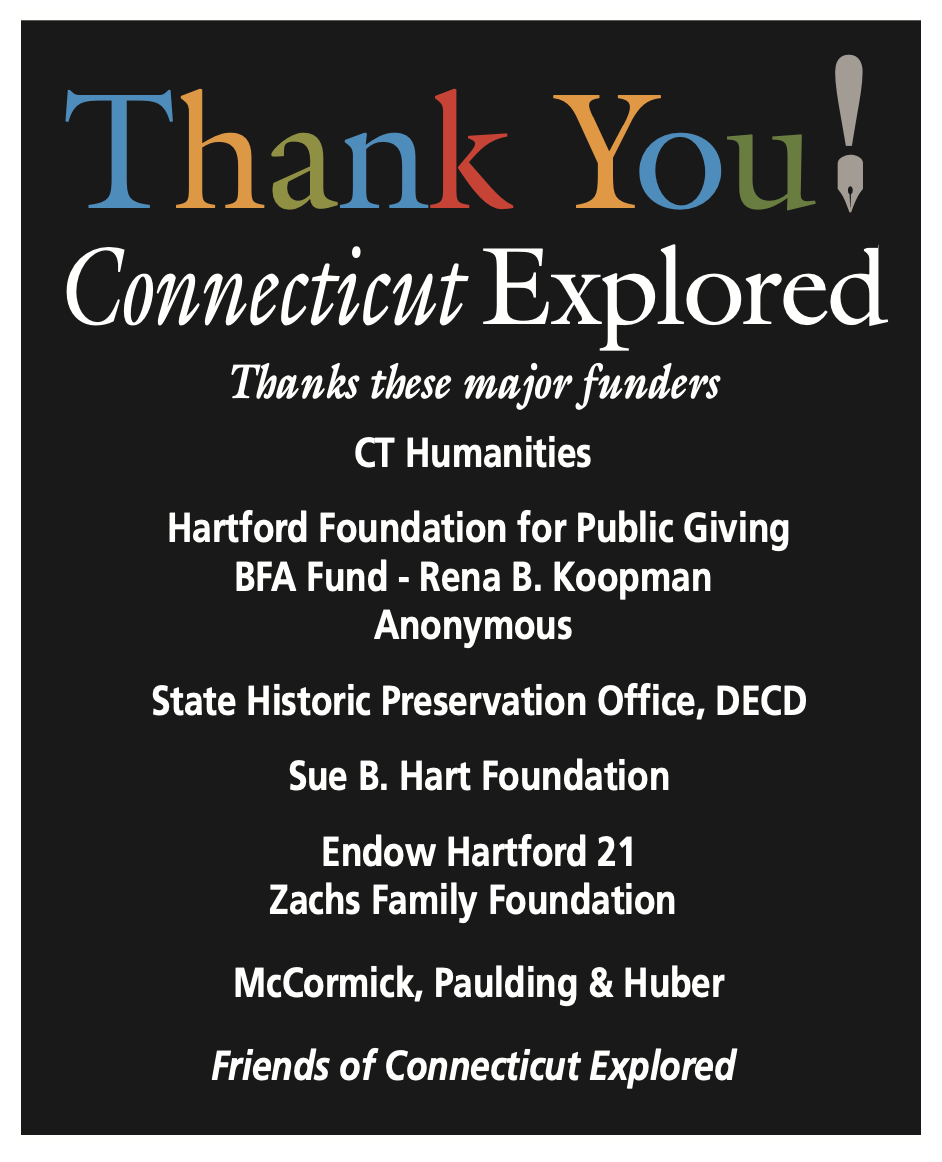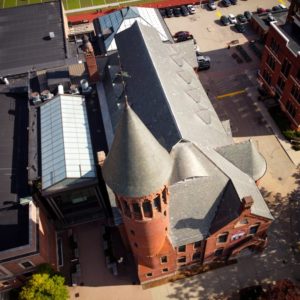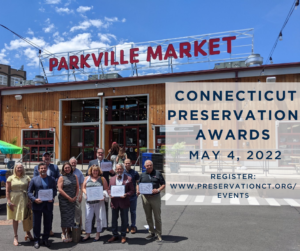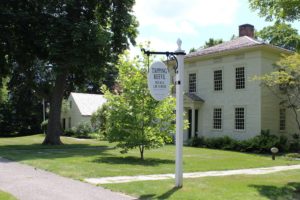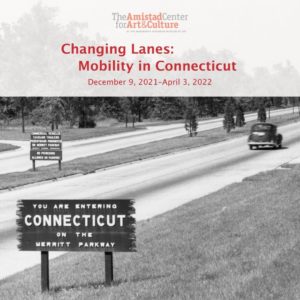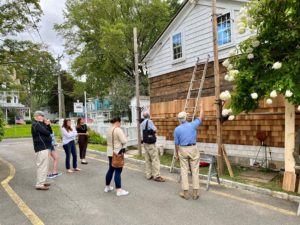Spring 2022 SPOTLIGHT
News and Events To See This Spring
From Connecticut Explored's Partners
Subscribe/Buy the Issue!
Pizza Dough Maker Acquired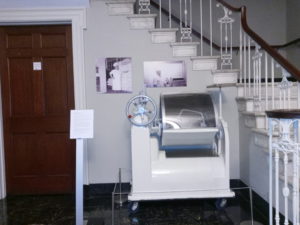 The odd-looking appliance on view in New Haven Museum’s rotunda represents a tasty slice of New Haven history. Ordered by Frank Pepe in 1939, this custom-designed machine mixed dough for his world-famous pizza for almost 65 years.
The odd-looking appliance on view in New Haven Museum’s rotunda represents a tasty slice of New Haven history. Ordered by Frank Pepe in 1939, this custom-designed machine mixed dough for his world-famous pizza for almost 65 years.
Born in Italy in 1893, Pepe later joined family members who had settled in New Haven. After returning to Italy to serve in World War I, he permanently settled in the Elm City in 1920. In 1925 Pepe opened a bakery on Wooster Street. A simple recipe from his homeland—dough, crushed tomatoes, grated Romano cheese, and sometimes anchovies—made him famous, and pizza transformed from a little-known ethnic dish to an American staple. By 1937 business was thriving. Pepe realized hand-mixing pizza dough was impractical and ordered his electric dough-mixing machine, donated by the grandchildren of Frank and Filomena Pepe.
New Haven Museum, newhavenmuseum.org
Lebanon’s 1869 Pastor’s Library
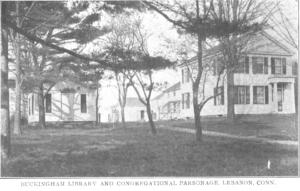 In 1864 Connecticut governor William Buckingham donated $1,000 to his parents’ church in Lebanon, which he attended as a boy. The gift was made to create a collection of books for the minister’s use. In 1869 the book collection was so large that the congregation decided to build a library to hold it. Rather than converting a room in the parsonage for this purpose, the church constructed a small free-standing building.
In 1864 Connecticut governor William Buckingham donated $1,000 to his parents’ church in Lebanon, which he attended as a boy. The gift was made to create a collection of books for the minister’s use. In 1869 the book collection was so large that the congregation decided to build a library to hold it. Rather than converting a room in the parsonage for this purpose, the church constructed a small free-standing building.
Ledgers donated by Buckingham provide documentation of the library collection and the creation and maintenance of the library building. At least five different ministers used and enjoyed the library, but eventually it became a somewhat neglected storeroom. As the church considered selling the parsonage property on which the library stood, the library building was donated to the Lebanon Historical Society to assure its long-term preservation. Moved to museum property in 2011, it was restored and opened to the public in 2012.
Lebanon Historical Society Museum, HistoryofLebanon.org
Two For the Road: Ernest Roth and Andre Smith in Europe is a special exhibition on view at the Mattatuck Museum March 20 to May 15. Two For the Road tells the story of Ernest David Roth (1879 – 1964) and Jules André Smith (above, 1880 – 1959), two American printmakers who were friends for 50 years. Although they were lifelong friends, their most remarkable work was inspired by their early travels together. The multiple sketching trips to Europe they made between 1913 and 1930 attest to their close fellowship. This exhibition includes more than 100 prints, 17 sketches, and two etched plates that track their travels throughout Europe. Prints by their friend John Taylor Arms will also be on view.
Mattatuck Museum, mattmuseum.org
Constructions & Reconstructions
An innovative artist and designer, Norman Ives pioneered the use of type and letterforms as primary subjects for his designs. Ives taught at the Yale University School of Art from 1952 until his death in 1978, finding success in a multi-faceted career as an artist, designer, publisher, and teacher. Constructions & Reconstructions, a large-scale exhibition on view at the Lyman Allyn Art Museum through April 24, explores the range and evolution of Ives’s work, with examples of his paintings, collages, prints, bas-reliefs, and murals. Whether designing corporate symbols or painting murals, Ives was guided by his love of letterforms in their whole or in fragments. He revolutionized the field of graphic design, and he and his Yale colleagues became a driving force in making graphic design a more rigorous profession. Illustrating the wide range of Norman Ives’s brilliant artistic output, Constructions & Reconstructions traces the artist’s enduring contributions to art and graphic design.
Lyman Allyn Art Museum, lymanallyn.org
Boat Show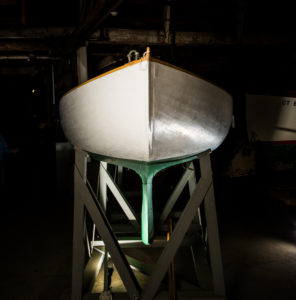 One of the greatest—and usually hidden—assets of Mystic Seaport Museum is its small watercraft collection, which numbers some 500 vessels of all shapes and sizes, from kayaks and modest rowboats to luxury motor launches. To provide access to boats that have not been displayed for some time—if ever—the museum is hosting a new exhibition, Story Boats, opening May 22 in the Collins Gallery.
One of the greatest—and usually hidden—assets of Mystic Seaport Museum is its small watercraft collection, which numbers some 500 vessels of all shapes and sizes, from kayaks and modest rowboats to luxury motor launches. To provide access to boats that have not been displayed for some time—if ever—the museum is hosting a new exhibition, Story Boats, opening May 22 in the Collins Gallery.
Instead of the usual focus on the boats’ technical and material aspects, this exhibition reveals their human stories. On view will be Vireo (above), Franklin D. Roosevelt’s small yacht that he sailed the last day he walked unaided before contracting polio. Also on view will be the sail training ship Albatross’s lifeboat that survived after the ship sank in a freak storm in the Caribbean in 1961, an event later chronicled in the 1996 movie White Squall starring Jeff Bridges. These are but two of many compelling stories that will be found in the exhibition.
Mystic Seaport Museum, Mysticseaport.org
Walking Tours Begin in May
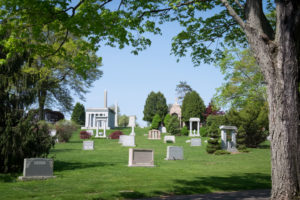 Learn about Cedar Hill Cemetery’s world of art, history, and natural beauty by attending Cedar Hill Cemetery Foundation’s popular public programs. Seasonal activities begin in May and run through October. For nature enthusiasts, there are bird, tree, and mushroom walks. Art and history lovers will enjoy thematic tours highlighting celebrated residents and renowned monuments. Program information can be found on the foundation’s website, cedarhillfoundation.org.
Learn about Cedar Hill Cemetery’s world of art, history, and natural beauty by attending Cedar Hill Cemetery Foundation’s popular public programs. Seasonal activities begin in May and run through October. For nature enthusiasts, there are bird, tree, and mushroom walks. Art and history lovers will enjoy thematic tours highlighting celebrated residents and renowned monuments. Program information can be found on the foundation’s website, cedarhillfoundation.org.
If you visit Cedar Hill Cemetery on your own, quiet recreational activities, such as walking, birding, and photography, are permitted. A Guide for Visitors, A Guide to Notable Trees, and Guide by Cell Audio Tour are available for self-guided experiences.
Cedar Hill Cemetery, cedarhillfoundation.org
Early American Inn & Tavern Signs
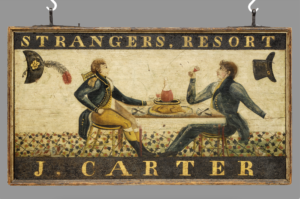 When was the last time you visited the largest and most spectacular collection of early American inn and tavern signsin the country? Between 1750 and 1850, American sign painters produced more than 50,000 inn and tavern signs, creating a distinct visual language and offering a glimpse into tavern life, travel, and patriotic ideals in early America. Only a fraction of these signs survive, and the Connecticut Historical Society’s collection numbers more than 60 objects, a rare and significant assemblage. You can view this special collection at the Connecticut Historical Society in the Inn & Tavern Signs of Connecticut exhibition.
When was the last time you visited the largest and most spectacular collection of early American inn and tavern signsin the country? Between 1750 and 1850, American sign painters produced more than 50,000 inn and tavern signs, creating a distinct visual language and offering a glimpse into tavern life, travel, and patriotic ideals in early America. Only a fraction of these signs survive, and the Connecticut Historical Society’s collection numbers more than 60 objects, a rare and significant assemblage. You can view this special collection at the Connecticut Historical Society in the Inn & Tavern Signs of Connecticut exhibition.
Connecticut Historical Society Museum & Library, chs.org
Nook Farm Walking Tour
The Harriet Beecher Stowe Center recently received funding from the National Endowment for the Humanities to develop Seeing is Revealing: Nook Farm Then and Now, a walking tour of Stowe’s historic neighborhood. From an artistic and activist enclave to a contemporary dynamic Hartford neighborhood, the tour will explore Nook Farm’s relationship to the history of residential development, urbanization, preservation, and the effects of each on racial and social injustices now.
Led by Amy Hufnagel, Director of Programs and Visitor Experiences at the Stowe Center, the tour’s development is a collaborative project with contributions from author Steve Thornton, scholars and experts in the field, and The Mark Twain House & Museum. The Nook Farm Walking Tour will be offered as an in-person, guided experience beginning in June 2022, and as a self-guided audio tour beginning in July. Sign up for the center’s e-blast and follow the HBSC on social media for continual updates on this exciting new tour opportunity.
Harriet Beecher Stowe Center, HarrietBeecherStoweCenter.org
Tribe, Parish, Town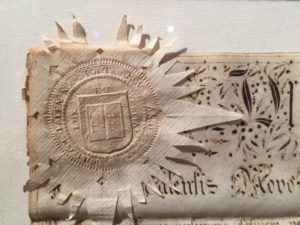 In Siwanog Tribe, English Parish, American Town, the early history of Wilton is traced through a selection of rarely seen objects from the Wilton Historical Society’s permanent collection. Native Americans lived in Wilton long before the arrival of Europeans. Members of the Siwanog tribe farmed, hunted, and fished in the fertile Norwalk River Valley. The first permanent English settlers were Jonathan Wood and his family, who moved from Long Island in 1706. After decades under the jurisdiction of Norwalk, Wilton voted to separate in August 1801. Included in the exhibition are Ponus tribe beaded moccasins and a pre-1800s indigenous bead necklace, a sumptuous crimson silk waistcoat c. 1760, a pair of dainty lady’s wedding shoes, c. 1742, and two marvelously preserved Yale University diplomas, one from 1761 and one from 1764, both awarded to David Lambert II.
In Siwanog Tribe, English Parish, American Town, the early history of Wilton is traced through a selection of rarely seen objects from the Wilton Historical Society’s permanent collection. Native Americans lived in Wilton long before the arrival of Europeans. Members of the Siwanog tribe farmed, hunted, and fished in the fertile Norwalk River Valley. The first permanent English settlers were Jonathan Wood and his family, who moved from Long Island in 1706. After decades under the jurisdiction of Norwalk, Wilton voted to separate in August 1801. Included in the exhibition are Ponus tribe beaded moccasins and a pre-1800s indigenous bead necklace, a sumptuous crimson silk waistcoat c. 1760, a pair of dainty lady’s wedding shoes, c. 1742, and two marvelously preserved Yale University diplomas, one from 1761 and one from 1764, both awarded to David Lambert II.
Wilton Historical Society, wiltonhistorical.org
The modernist American painter Milton Avery (1885 – 1965) expressed his vision of the world through harmonious color and simplified forms. His career spanned the movements of American Impressionism and Abstract Expressionism, yet in light of these major artistic traditions, he forged a staunchly independent path as an artist. Milton Avery, on view at the Wadsworth Atheneum March 5 – June 5, is the first retrospective exhibition of Avery’s work in the United States in 30 years. It brings together a selection of 60 artworks representative of Avery’s signature themes, including scenes of daily life, portraits, serene landscapes, and large-scale abstractions. Organized by the Royal Academy of Arts, London, the exhibition will travel internationally. Its presentation at the Wadsworth is a significant homecoming, considering that Avery grew up outside Hartford, took his first art classes at the Wadsworth, and essentially learned to become an artist by exploring Connecticut.
Wadsworth Atheneum Museum of Art, thewadsworth.org
Sculpture Honors Suffragists
In March Hartford Public Library will unveil a sculpture by Greater Hartford artist Marilyn Parkinson, who is creating a three-dimensional dress depicting the popular design of the early 19th-century women’s suffrage era. The piece marks the recent 100th anniversary of the passage of the 19th Amendment in 1920 and honors the many Hartford women who, despite barriers, registered to vote in the city in October 1920. The sculpture will incorporate reproductions of voter registration cards from some of the first women who registered to vote in Hartford that were scanned and digitized as part of the Hartford History Center’s October 1920 online exhibit. Funding for the commission was provided by the Edward C. and Ann T. Roberts Foundation, and the sculpture will be located in the Hartford History Center at the downtown library branch.
Hartford Public Library, hplct.org
The Friends of Wood Memorial Library happily announce the return of the library’s performance lecture series. This spring meet Martha Washington (March 23), Lizzie Borden (April 27), and Diana of Love (June 10), portrayed by actors Maggie Worsdale, Lynne Moulton, and Judith Kalaora, respectively. Register at WoodMemorialLibrary.org.
Wood Memorial Library & Museum, Woodmemoriallibrary.org
Democracy Center Welcomes Staff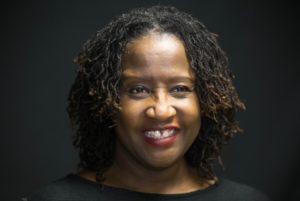
The Connecticut Democracy Center (CTDC) welcomes Tammy Denease to its team as Director of Outreach for the Connecticut Freedom Trail. Over the next two years, Denease, the CTDC, the Connecticut Freedom Trail Committee, and the State Historic Preservation Office will expand our understanding of Connecticut history by researching and sharing a Freedom Trail narrative focused on movements toward freedom, justice, and full citizenship. Denease will make resources available to schools and the public through statewide outreach, including a new website designed to share the stories, activities, and sites of the Freedom Trail. Site visits, programs, and training opportunities will enrich the work of sites along the trail and identify new additions to this important collection of historic assets. Denease brings museum experience to the project, and experience performing first-person portrayals of historical figures such as Margu, a child captive on the Amistad schooner.
Connecticut Democracy Center at Connecticut’s Old State House, ctdemocracycenter.org
[Her]Story: Women's Roles Through History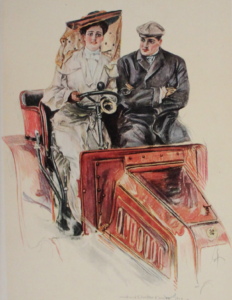
Through May 5, Pequot Library presents [Her]Story: Women's Roles Through History, an exhibition about the evolution of the roles of women in society from the 1700s forward. Selected items from the library’s Special Collections reveal the impressive accomplishments of women over time, highlighting local and national figures such as Ella Grasso, Mabel Osgood Wright, and Amelia Earhart. Join Pequot Library for a walk through Colonial America, the Gilded Age, the Women’s Suffrage movement, employment in World War I and II, all the way up to modern life. Exploring through text, visual representations, and fashion, follow visionary women through [her]story, and bear witness to their strength and resilience as they move from pedestals to protests, from boredom to boardroom, to lead and to love. [Her]Story will be open to the public during library browsing hours.
Pequot Library, Pequotlibrary.org
Historic Wallpaper to be Restored
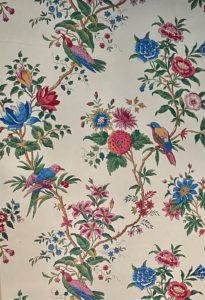 Connecticut Landmarks (CTL) is undertaking a three-phase wallpaper restoration project at the Bellamy-Ferriday House & Garden in Bethlehem. An evaluation of the papers in the house resulted in the decision to remove and replace the wallpaper in three main areas of the house with reproduction papers. The extent and distribution of the damage to the wall coverings in the more than 250-year-old house was caused by normal light exposure, water (dating to the early 1960s), wear, and settling of the house. CTL is working with wallpaper reproduction expert Laura McCoy Designs Inc. to color match and reprint the paper for phase one (the front entryway and landing) and phase three (the back hallways and stairs). Fortunately, the pattern for phase two (Caroline Ferriday’s bedroom) is still being produced by Bradbury & Bradbury Art Wallpapers. The decision to reproduce the early 20th-century wallpapers demonstrates CTL’s commitment to honoring Caroline Ferriday’s legacy and preserving her design choices. To read more about the project visit ctlandmarks.org/in-the-news/preservation-updates.
Connecticut Landmarks (CTL) is undertaking a three-phase wallpaper restoration project at the Bellamy-Ferriday House & Garden in Bethlehem. An evaluation of the papers in the house resulted in the decision to remove and replace the wallpaper in three main areas of the house with reproduction papers. The extent and distribution of the damage to the wall coverings in the more than 250-year-old house was caused by normal light exposure, water (dating to the early 1960s), wear, and settling of the house. CTL is working with wallpaper reproduction expert Laura McCoy Designs Inc. to color match and reprint the paper for phase one (the front entryway and landing) and phase three (the back hallways and stairs). Fortunately, the pattern for phase two (Caroline Ferriday’s bedroom) is still being produced by Bradbury & Bradbury Art Wallpapers. The decision to reproduce the early 20th-century wallpapers demonstrates CTL’s commitment to honoring Caroline Ferriday’s legacy and preserving her design choices. To read more about the project visit ctlandmarks.org/in-the-news/preservation-updates.
Bellamy-Ferriday House & Garden, Ctlandmarks.org
Greenwich Historical Society has several important preservation projects underway at its c. 1730 Bush-Holley House, a National Historic Landmark. Window and siding repairs and refurbishment of the two-story front porches were completed last fall; additional projects are continuing this spring. The house is open for docent-led tours while work is ongoing, thanks to a generous grant from the Connecticut Historic Restoration Fund.
The Bush-Holley House is central to the society’s work with the Witness Stones Project (witnesstonesproject.org), launched in 2020 to recognize the lives and contributions of enslaved people who lived there. Working with local schools, the society supports primary research so that students better understand the reality of slavery in New England. In April the society will hold its second annual Witness Stones Dedication Ceremony to honor Jack and Cull Jr., two boys who were enslaved at the Bush-Holley House from their births c. 1801 – 1802 until c. 1822 – 1823.
Greenwich Historical Society, Greenwichhistory.org
Words for a Good Cause
Wordie. Logophile. If language is your jam, you’ll love Webster’s War of the Words—a clever game show on May 14 hosted by Peter Sokolowski, editor at large at Merriam-Webster Dictionary. This fundraiser for the Noah Webster House challenges two teams of celebrity contestants—and the audience—in a battle of words and wit. Learn more at noahwebsterhouse.org.
Noah Webster House & West Hartford Historical Society, noahwebsterhouse.org
Spring Conference
The Association for the Study of Connecticut is sponsoring a series of webinars and a spring conference about “Teaching History in Difficult Times.” Since 1970 ASCH has promoted the study of the history of Connecticut via meetings and conferences. In 1974 it began publishing a twice-yearly journal, now called Connecticut History Review. Visit Asch-cthistory.org for more information.
Excellence in Needle Craft
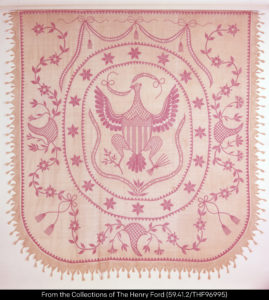 The domestic textiles produced in New London County from the mid-18th to the early 19th century stand out today as masterpieces of American needle craft. New London County Quilts & Bed Covers, 1750‒1825, a special exhibition curated by independent scholar Lynne Z. Bassett on view through May 1, examines the artistic excellence of American needle craft within the context of design inspiration drawn from an array of transatlantic sources and explores the question of how the county fostered such exceptional work.
The domestic textiles produced in New London County from the mid-18th to the early 19th century stand out today as masterpieces of American needle craft. New London County Quilts & Bed Covers, 1750‒1825, a special exhibition curated by independent scholar Lynne Z. Bassett on view through May 1, examines the artistic excellence of American needle craft within the context of design inspiration drawn from an array of transatlantic sources and explores the question of how the county fostered such exceptional work.
Quilted petticoats with maritime motifs, bold geometric patterns on bed rugs, sophisticated feathers and fruit stitched on elegant whitework quilts, and patriotic appliqués reveal the range and accomplishment of New London County women. The exhibition unites, for the first time, examples by these makers, only some of whose names are known but whose textiles survive as evidence of the network of connections between teachers, students, and family members.
Florence Griswold Museum, florencegriswoldmuseum.org
Major Roof Project
In 2022 Slater Memorial Museum of Norwich Free Academy, dedicated in 1886, will embark on a restoration of its original 135-year-old roof. This is the first project of its kind to be performed on the museum building and will be a comprehensive restoration of the entire roofing system. Because of the nature of the project, the museum closed to the public on January 1 and will aim to reopen toward the end of 2022. The museum’s collection and exhibitions will be preserved, and in some cases relocated, to maintain their safety and allow for a safe and seamless restoration process. While the museum itself will be closed temporarily, the staff will be hard at work behind the scenes connecting with students and the public through digital means, and we invite everyone to join us on this exciting journey. Visit slatermuseum.org to learn more and stay updated throughout the restoration!
Slater Memorial Museum, slatermuseum.org
Hudson River School Landscapes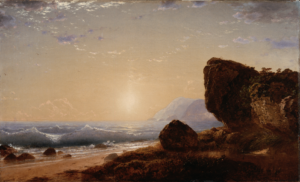 The New Britain Museum of American Art presents The Poetry of Nature: Hudson River School Landscapes from the New-York Historical Society, on view through May 22. Encompassing a stunning array of more than 40 paintings created between 1818 and 1886, the exhibition illustrates America’s scenic splendor as seen through the eyes of more than 25 leading Hudson River School artists including Thomas Cole, Asher B. Durand, John F. Kensett, Albert Bierstadt, and lesser-known but important artists Josephine Walters, Christopher Pearse Cranch, and Louisa Davis Minot, among others. Plan your visit at nbmaa.org.
The New Britain Museum of American Art presents The Poetry of Nature: Hudson River School Landscapes from the New-York Historical Society, on view through May 22. Encompassing a stunning array of more than 40 paintings created between 1818 and 1886, the exhibition illustrates America’s scenic splendor as seen through the eyes of more than 25 leading Hudson River School artists including Thomas Cole, Asher B. Durand, John F. Kensett, Albert Bierstadt, and lesser-known but important artists Josephine Walters, Christopher Pearse Cranch, and Louisa Davis Minot, among others. Plan your visit at nbmaa.org.
New Britain Museum of American Art, Nbmaa.org
Join Preservation Connecticut for its 2022 Connecticut Preservation Awards on Wednesday, May 4! Preservation CT will celebrate an array of outstanding projects and the preservationists who have endured the hardships of a multi-year pandemic and still succeeded in finding creative and innovative ways to reuse and revitalize Connecticut’s precious historic resources. The awards will honor projects that bring new life to distressed buildings, districts, or communities; revitalize sites important to communities often neglected by mainstream preservation; contribute to sustainability; or bring new perspectives or methods to historic preservation.
This year’s celebration is especially important as it is hoped it will be in person for the first time in two years. You can find out how to register at its website: preservationct.org/events. Preservation CT hopes to see you there!
Litchfield Historical Society museums re-opens for the season on April 30! Updated for the new year, the exhibition Antiquarian to Accredited invites visitors to learn more about the society and gain an insider’s perspective on how a museum collects, interprets, and shares community history.
Also reopening is the ever-popular Tapping Reeve House and Litchfield Law School, the nation’s first law school. Through role-playing, hands-on areas, and interpretive exhibits, each visitor takes a journey through the 19th-century life of a real student who came to Litchfield for an education at the law school or the Litchfield Female Academy. Graduates of these schools range from famous to infamous, including vice presidents Aaron Burr and John C. Calhoun and more than 100 federal lawmakers and judges. Admission is FREE!
Litchfield Historical Society; Tapping Reeve House and Litchfield Law School, litchfieldhistoricalsociety.org
Black Mobility Explored
Many of us take the ability to move easily and freely for granted. From the Amistad Case of 1841 to the struggle for equality today, though, Connecticut has a long and complicated history related to African American mobility. Because of prejudice, the United States created barriers by law for African Americans in travel, housing, education, and excessive policing. Over many generations, this inequality generated responses from local community members and activists to encourage positive change.
Inspired by Gretchen Sullivan Sorin’s book Driving While Black, Changing Lanes: Mobility in Connecticut, a special exhibition on view at The Amistad Center for Art & Culture through April 3 explores the successes, struggles, and ongoing efforts of activists fighting for racial equality in Connecticut. But the question remains: what barriers still exist today, and how can we eliminate them? Visit amistadcenter.org for more information.
The Amistad Center for Art & Culture at the Wadsworth Atheneum Museum of Art, AmistadCenter.org
Discoveries at Keeler Tavern Museum
The historic tavern at Keeler Tavern Museum & History Center in Ridgefield is undergoing significant exterior repair, restoration, and preservation. As a result, the museum has learned more about the structure, built c. 1713 with later additions. Restoration specialist Jan Desiato discovered and verified significant timelines and structural details, including that the kitchen addition, previously thought to have been built in the 1790s for Esther Keeler, was built c. 1820s by her son William Keeler. Hand-scraped chestnut boards and nails used in the construction of that addition were recycled from previous uses. Some nails were hand-wrought, indicating 18th-century manufacture, while others showed signs of 19th-century machine manufacture. The museum also learned that the white-shingled tavern was originally built with clapboard and likely painted rust red.
You are invited to visit the museum to see the project in action! The museum thanks the Society of the Cincinnati and the 1772 Foundation for underwriting this important historic preservation work.
Keeler Tavern Museum & History Center, Keelertavernmuseum.org
Tours and Talks at Twain
The Mark Twain House & Museum is open for guided tours year round. Due to COVID safety precautions, tour sizes are limited and tours often sell out ahead of time, so it’s best to reserve your spot in advance online. The museum offers a general tour filled with family anecdotes and history; living history tours featuring costumed actors portraying butler George Griffin, the Clemens family’s gossipy maid Lizzie Wills, and woman-of-the-house Livy Clemens, and a kids’ tour about the everyday life of daughters Susy, Clara, and Jean Clemens. For a full schedule and tour options visit MarkTwainHouse.org.
Every week the museum hosts best-selling authors, many in partnership with Harper’s Magazine. Authors talk about their latest books in conversation with an intriguing host. Recent guests have included Joyce Carol Oates, Preston & Child, Touré, Jodi Picoult, and Michael Connelly, among others. For information about upcoming virtual and in-person author programs and special Twain-related lectures visit MarkTwainHouse.org/Events.
The Mark Twain House & Museum, MarkTwainHouse.org
Hill-Stead Celebrates 75
Turning 75 in 2022, Hill-Stead Museum plans to go all out! It will celebrate its founder’s birthday in early February; on March 27, the inaugural Art of Shearing: A Sheep to Shawl Festival, explores transforming raw wool—from its resident sheep!—into wearable garments; May brings the perennial favorite, May Market, and a diamond anniversary gala like no other.
Hill-Stead Museum, 35 Mountain Road, Hillstead.org
Modernizing Two Cemeteries 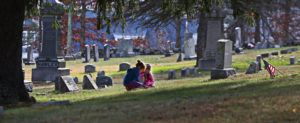 The collaboration between Brookfield’s Laurel Hill Cemetery, a Connecticut State Historic site, and Central Cemetery continues to expand, as does outreach to others seeking to regionalize, professionalize, and modernize cemetery operations.
The collaboration between Brookfield’s Laurel Hill Cemetery, a Connecticut State Historic site, and Central Cemetery continues to expand, as does outreach to others seeking to regionalize, professionalize, and modernize cemetery operations.
One initiative has been installation of beehives in collaboration with professional beekeeper, Mike Rice of Roxbury. Wendy Ford of Old Saybrook-based Atlas Outdoor Living is overseeing production of custom-designed sheds to house the hives.
A second initiative is adopting an open source-based mapping system developed by Ramaker & Associates, a Wisconsin-based, employee-owned, architecture and engineering firm with over 1,000 cemetery clients, including the U.S. Naval and Air Force academies, numerous Catholic dioceses, and the State of Illinois.
A third initiative, in the planning stages, is to restructure as a member-owned cooperative modeled after those in the agricultural, grocery, and credit union industries. Thanks to Joanne Todd of Northeast Family Credit Union, Alice Rubin of the Willimantic Food Cooperative, and others for passage of Public Act No. 19-65, which modernizes Connecticut’s cooperative association statutes. For more information visit centralcemetery.net.
A Records Preservation Case Study
Judicial proceedings reflect a society’s laws, ethics, morals, and customs, and that makes court records an invaluable resource for historians, genealogists, authors, and others. Part of the Connecticut State Library’s mission is to preserve the state’s historical records. State Archives staff is working to safeguard New Haven County Court records from 1666 to 1855 through a combination of traditional archival methods and digitization. Archival methods include unfolding documents that had been stored in envelopes and placing them in acid-free folders and boxes. This reduces wear and tear caused by unfolding and refolding. Appropriate labels on folders and boxes and subject indexing also reduce handling and therefore wear and tear.
Digitization, the other strategy, preserves records by reducing the need to physically handle them. Unfortunately, it is not financially feasible to digitize every single record due to the volume—approximately 222 cubic feet worth. The State Library thanks the National Historical Publications and Records Commission for its generous support of the “Uncovering Hidden Resources in New Haven Court Records” project.
Connecticut State Library, Ctstate.library.org

